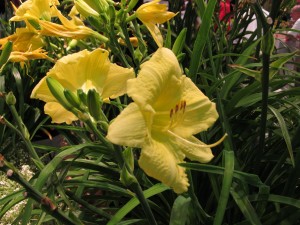Gardeners become disappointed when their daylilies (Hemerocallis spp.) are not bloom. There may be reasons for this including: old clumps in need of dividing, inadequate nutrition, too much nitrogen fertilizer, too much shade, and pest and disease issues.
Daylilies may be shaded or crowded out by overgrown trees, shrubs, ground covers, or weeds. Heavy amounts of grassy weeds, including nutsedges may strangle clumps. Overcrowded daylilies become nutrient starved which reduces their growth and flowering.
As a rule, existing daylily clumps should be dug up and divided every 5-6 years. Early fall is the best time to lift and divide daylilies. They may also be divided in late winter, once outside temperatures have moderated. In most U.S. regions, daylilies should not be divided after mid-October as transplants may heave out of the freezing/thawing ground over the winter. Mulching newly transplanted beds is beneficial to thwart heaving and for winter protection.
Prepare a new planting area, adding lots of well-rotted compost to the soil. The site should receive three-quarter to full day direct sunlight. Each division should include 2 to 3 fans and spaced 18 to 24 inches apart. Cut foliage back to 6 to 8 inches.
Choose divisions with lots of thick white roots. Newly-divided daylilies may bloom sparsely their first summer. This is normal. When dividing plants, discard poor clumps, particularly those with dead or wilted foliage. Dispose with the household trash and do not place into the garden compost pile.
It’s not necessary to fertilize new or reworked daylily beds in the fall. Feed in early spring with a slow release fertilizer such as Osmocote 14-14-14, Nutricote 13-13-13, or equivalent products.


 Posted in
Posted in 
